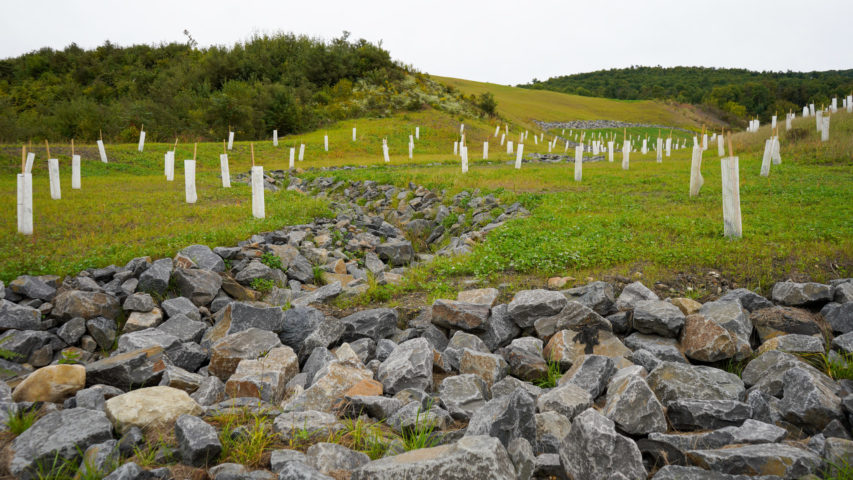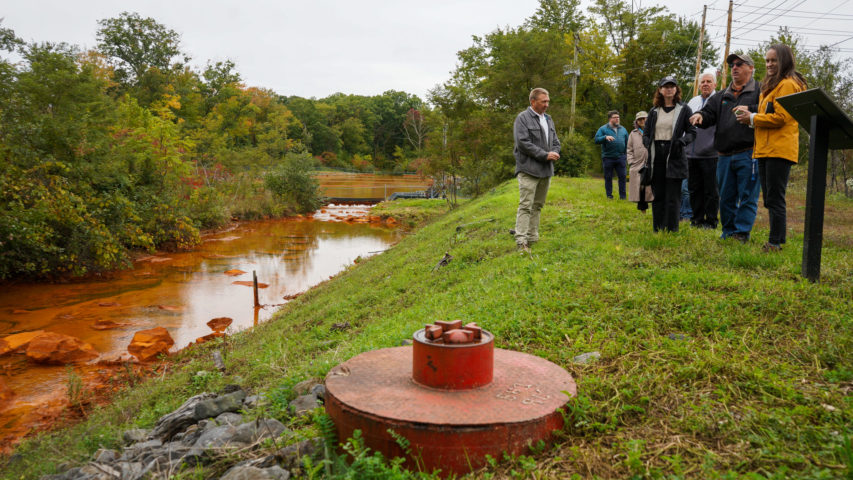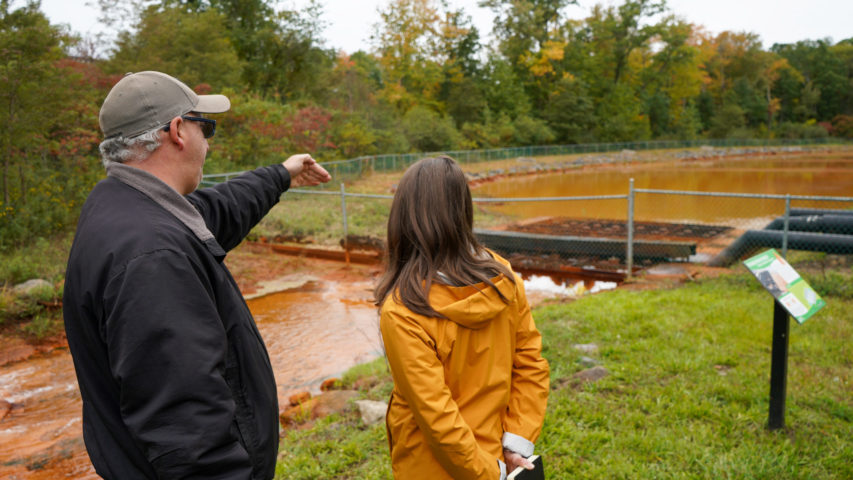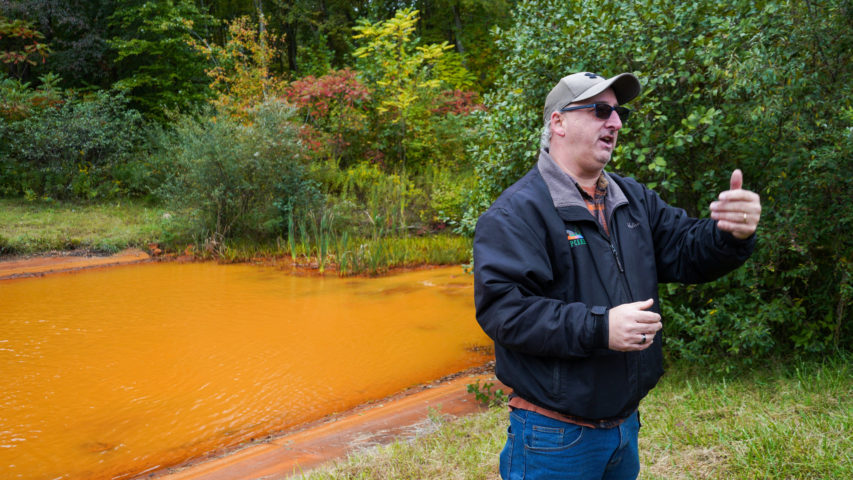We have much more to do and your continued support is needed now more than ever.
Mine-scarred Land and Orange Rivers–a Story of Land Degradation and Reclamation in Pennsylvania
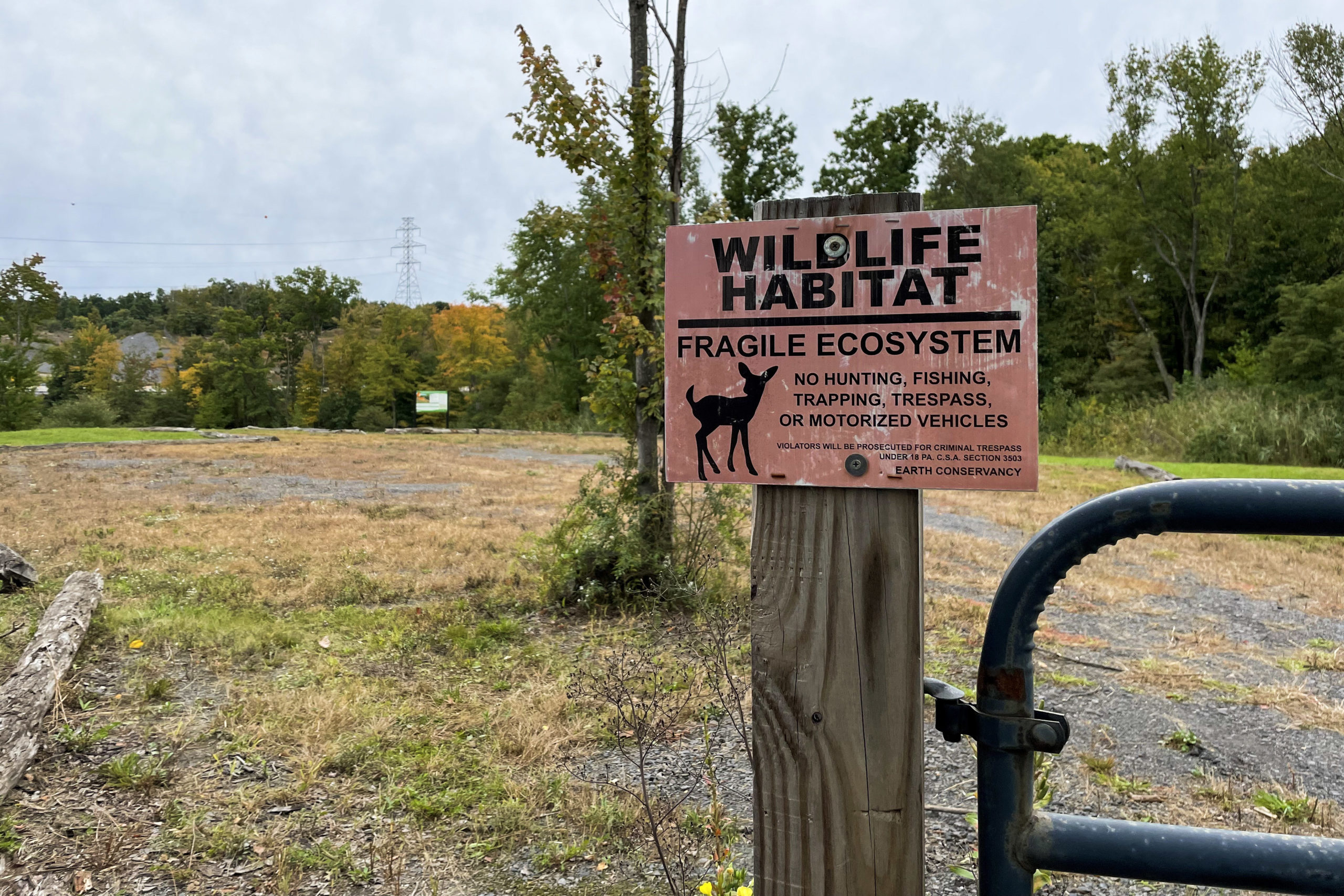
Over 5,000 abandoned underground mines dot the landscape in Pennsylvania. And although these underground channels are near invisible from the surface, there is one identifying factor you can’t miss. Bright orange water contaminated with heavy metals from acid mine drainage (AMD) flows from these underground mines and back into the watershed and nearby reservoirs. This highly acidic water coats streams with a thick slime, making the water undrinkable, destroying habitat, and poisoning plant and animal life. Reclamation is a necessary tool to ensure water quality and land are restored for future generations and wildlife.
The National Wildlife Federation recently visited two sites in northeastern Pennsylvania to highlight the important reclamation work taking place on the ground that will have positive impacts on millions of Pennsylvanians within the watershed as well as the communities downstream. The reclamation work at these two sites – Epsy Run Stream and the Askam Borehole Treatment System – is being led by the Earth Conservancy and the Eastern Pennsylvania Coalition for Abandoned Mine Reclamation (EPCAMR) among other local, state, and federal partners.
Epsy Run Stream
Epsy Run Stream is a severely impacted tributary of the Nanticoke Creek and is undergoing active restoration. The stream disappears underground and runs through 200 acres of legacy mine land, resurfacing with little to no flow, acid mine drainage contamination, and poor vegetation and biological health. Restoration, reforesting, and retrofitting of Epsy Run and other similar stream channels are underway to reconnect the greater watershed and avoid the underground contamination that pollutes the water. Bobby Hughes from EPCAMR highlighted that “this kind of work needs to happen up and down the watershed. There are many other sites in Pennsylvania that present this kind of opportunity to marry ecosystem restoration and habitat support with economic diversification and development.”
Askam Borehole Treatment System
Boreholes serve a vital purpose for the reclamation project in this region. With nowhere to go, the underground minewater often flooded local homes and businesses, creating millions of dollars in damage and public health concerns. Boreholes were drilled to fix the problem by relieving that pressure. The red borehole seen above pumps water from the underground mine into the stream channel and filters it down to the maelstrom oxidizer which treats the acid mine drainage. Powered by electricity, this is a treatment facility that requires ongoing operations and maintenance to clean the contaminated water in perpetuity. Jeffrey Lapp, Chief of the Watersheds Branch at the Environmental Protection Agency, was also in attendance and noted that the benefits of reclamation like this are far-reaching downstream and can have an impact on major watersheds like the Delaware, Chesapeake Bay, and Ohio River.

Economic Opportunities in Reclamation
James Kunz from the Pennsylvania Foundation for Fair Contracting (PAFFC) joined us to speak on the labor needs during reclamation and restoration projects, and how the recent infusion of federal reclamation dollars is an opportunity to build a long-term workforce through high-quality apprenticeships. Recent findings show that a four-year union apprenticeship program has an equal economic impact for a person as getting a bachelor’s from a state college. “We have a real opportunity here, not to be like the coal barons of the past, but to actually uplift people and build the workforce of the future,” James said. The Safelite building is part of this reclamation project to provide economic opportunities on a formally degraded site.
Investments in Degraded Land Reclamation
The National Wildlife Federation released a report on the climate, social, and economic benefits of reclaiming abandoned mine lands as well as orphaned oil and gas wells, Superfund sites, and brownfields. Recently, there has been significant federal investment in the reclamation of degraded lands. The Bipartisan Infrastructure Law (BIL) allocates $21 billion to reclamation efforts and the Inflation Reduction Act reinstates the Superfund tax on oil and petroleum companies, which will provide additional funding to the EPA for Superfund cleanup. “There’s a really great opportunity to make huge progress on this. We know the problem is vast with four million degraded lands across the United States and millions of acres in Pennsylvania alone,” added Jessica Arriens, program manager for climate and energy policy at NWF.
This historic funding brings us one step closer to cleaning up harmful polluted sites and creating opportunities on that land in the form of natural restoration and carbon sequestration, economic opportunities, and recreational projects that can positively impact people and wildlife.
What More We Can Do
Although these policies provide funding for reclamation efforts, they do not provide dedicated funding for acid mine drainage treatment which is vital to restoring the health of our waterways, our communities, and biodiversity. The STREAM Act would bridge this gap by authorizing states to dedicate up to 30 percent of their annual BIL abandoned mine lands grant to the treatment and abatement of acid mine drainage. As noted earlier, AMD is an issue that needs ongoing attention and the STREAM Act would make that possible. With strong bipartisan support, it has passed the House and is awaiting a hearing and passage in the Senate. Urge your Senators to take up the STREAM Act and help clean up waterways across coal country.
You can learn more about the climate, community, and economic benefits of reclaiming and restoring degraded lands from our recent report.

